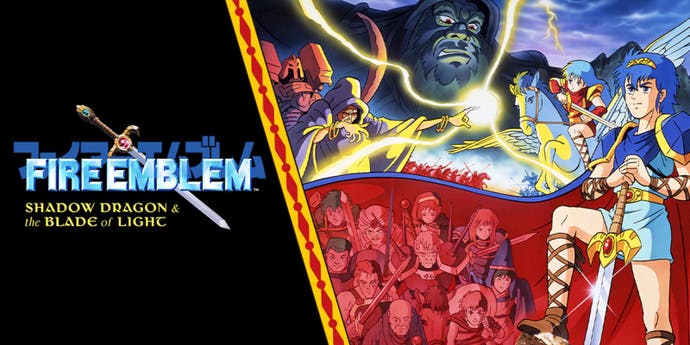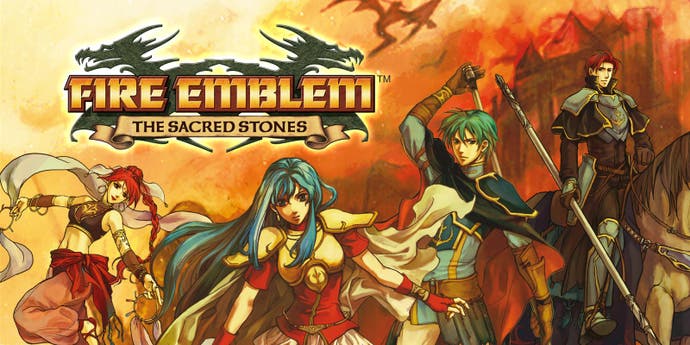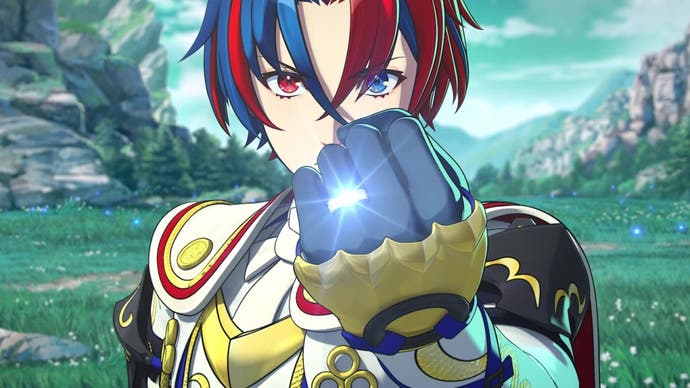A Fire Emblem retrospective: A history of RPG excellence
Of Marth and men.
RPGs aren't necessarily the first thing you'd associate with Nintendo, but I became a fan of the genre through Nintendo's efforts. My fate was sealed after a friend loaned me Fire Emblem Awakening, and it wasn't long before I'd beaten it twice. Giving me control of an army and building supports between its generals, Fire Emblem clicked immediately, and I've remained a huge fan ever since. Once I began exploring the older entries, I realised Fire Emblem holds a richer history here than you might expect, and it all began on the NES.
Initially envisioned by designer Shouzou Kaga, Fire Emblem: Shadow Dragon and the Blade of Light marked a joint development effort between Intelligent Systems and Nintendo R and D1. Looking to create a narrative-focused RPG, Shadow Dragon took us to Archanea, playing as Prince Marth. Kaga and the team wanted us to care about these characters, making them unique with different unit classes. If you behave recklessly, they can die permanently, and the development team wanted players to deal with that too. It all helped define tactical RPGs - though you wouldn't know it in the West. DS remake aside, Shadow Dragon went unlocalised until 2020, following a (now delisted) digital Switch release for the 30th anniversary.
But I'm getting ahead of myself there. Back in the 90s, Nintendo realised it had a hit, and sequels swiftly followed. Two years on, we had Fire Emblem Gaiden, a game that linked into Shadow Dragon but mostly provided its own adventure. This time, we visited the neighbouring continent, Valentia, a land split between two warring nations. Adopting new gameplay mechanics like an explorable overworld, Gaiden wasn't as well received, and its new changes were largely abandoned as a result. Though Gaiden remains unlocalised, there's a fantastic 3DS remake, Fire Emblem Echoes: Shadows of Valentia, that largely redeems these perceived flaws.
Come 1994, Intelligent Systems returned to Archanea on SNES with Fire Emblem: Mystery Of The Emblem. Remaking Shadow Dragon and calling it "Book 1", this included a brand-new story known as, you guessed it, "Book 2". Set two years later, Emperor Hardin has begun aggressively invading other countries, and it's down to Prince Marth to stop him, bringing a fitting conclusion to Marth's saga. The end result was Fire Emblem's most successful game in sales until Awakening. Like Shadow Dragon, this also had a DS remake, New Mystery of the Emblem, which remained Japan-exclusive. Crucially, it introduced Casual Mode to disable permanent death, and that later became a staple of modern Fire Emblem games.
Fire Emblem on SNES wasn't done yet, Intelligent Systems had further stories to tell with the Jugdral duology. Starting with Genealogy of the Holy War, this took us between two generations, as cultists across the Jugdral continent seek to revive an ancient dragon, Loptous. Fans consider it one of the better early games, making the lack of localisation criminal, and there's no remake to rely upon this time. Finishing this duo was Thracia 776, set between the generational gap, and it marked the last time Kaga worked on Fire Emblem. Finally, we had the Archanea Saga, a four-part downloadable set of episodes through the SNES' Satellaview service, which later appeared in New Mystery of the Emblem.
It wasn't too long before Fire Emblem returned, yet it never graced the Nintendo 64, though this is not for a lack of trying. Dubbed Fire Emblem 64 or Fire Emblem: Ankoku no Miko, details are scarce on this cancelled entry and only one screenshot was ever released publicly. 64 would've featured Roy as the main lord, who curiously was first known as Ike. Other notable names like Ephraim and Idunn were seen here, but these characters otherwise have little resemblance to their final versions.

Ultimately, difficulties with the hardware led to this project's cancellation, and Ankoku no Miko served as a very early version for the first GBA entry in 2001, The Binding Blade. Taking us to a brand-new continent, Elibe, Roy finally had his chance to shine, and we saw him opposing an invasion from the Bern kingdom. Initially developed as a companion game, it soon received a prequel with The Blazing Blade, focused on Roy's father, Eliwood.
Both were well received, though Blazing proved a major turning point. For the first time in its history, Fire Emblem had been localised in the West. That's largely thanks to Super Smash Bros. Melee, which included both Roy and Marth as playable characters, as game director Masahiro Sakurai wanted more sword wielding fighters. Fire Emblem had its big Western break and being convinced by this success in Melee, Nintendo localised (almost) every entry in North America and Europe since.
We had one more GBA entry in 2004, The Sacred Stones, featuring a different Ephraim with his sister Eirika. However, it wasn't until the following year that Fire Emblem finally graced a home console once again, introducing us to the Tellius Series. Rather than a prince or some other form of nobility, Path of Radiance on Gamecube had us playing as a mercenary instead called Ike, opposing an invasion by the cruel King Ashnad of Daein.

Having successfully fended off this mad king, a direct sequel followed on the Wii in 2008, Radiant Dawn. Exploring the post-war ramifications three years on, we found Daein's become occupied by a corrupt neighbouring empire, exploring several new storylines. Unfortunately, while both were well received, series sales had been gradually declining. A second Wii game was quietly cancelled, which would've been more experimental than its predecessors. It wasn't until the 3DS that we finally saw another original entry, and it certainly paid off.
It's no stretch to say Fire Emblem Awakening could've been the series' last hurrah. Taking elements from all of the previous games, we finally returned to Archanea and Valentia, now called Ylisse and Valm respectively, set 2000 years after the first game. Playing as one of Marth's distant descendants, Chrom, Awakening took the dual protagonist approach, and he was joined by tactician Robin, both of whom later appeared in Super Smash Bros.
Creating an accessible entry point into the series, Awakening became a hit commercially and critically, revitalising the series. New social elements were introduced through an expanded support system, pairing up characters for marriage who'd then have kids, who'd become playable units thanks to the time-travelling storyline. Work soon began on Fire Emblem Fates, which introduced a split narrative approach in Fire Emblem, letting our new protagonist Corrin choose which royal family they'd like to side with.

It'd be four years before we saw another main entry, yet Fire Emblem fans weren't exactly lacking in between. 2017's Shadows of Valentia remake aside, several Fire Emblem spin-offs also appeared. Tokyo Mirage Sessions created an unusual idol-focused crossover with Shin Megami Tensei, Heroes provided an original mobile entry, while Fire Emblem Warriors took a "best of Fire Emblem" approach, replacing turn-based gameplay with musou combat. All in all, a mixed selection.
Then came Three Houses, kicking off the Fódlan series. Reusing Fates' split narrative approach, we played as Byleth, a former mercenary turned professor at Garreg Mach Monastery, and your chosen house determined your storyline, with no one canon path to pick. Taking social elements further, it retained the marriage system from the 3DS games but incorporated more activities outside of battles, like fishing and cooking. Questionable fruit visuals aside, Three Houses saw widespread acclaim, becoming the best-selling entry yet. It's little surprise then that Nintendo followed it with Fire Emblem Warriors: Three Hopes, another musou spin-off set in an alternative timeline.
Looking back, elements of those early games remain clear even in new entries. As the player, you feel like the unseen tactician, literally so in The Blazing Blade and we're still using that turn-based system now, commanding individual generals and weighing up enemy weaknesses. Casual mode has become a mainstay, yet Classic mode remains for those willing to risk it all. Every decision counts here and all it'd take is one poorly timed crit for permadeath, adding a big sense of accomplishment to battles.
Kaga's idea to get players invested in this story still influences it now, and that's best seen through the support system. The specifics vary depending on the entry, sure, but Fire Emblem never feels like we're commanding a group of one-dimensional soldiers. Giving airtime to dozens of playable characters isn't always feasible in the main story, so these supports give our favourites a chance to grow off the field. By expanding the social gameplay, Three Houses took this to a new level, and you really feel involved in the day-to-day life of this world.
For a series thought to be on its last legs a decade ago, it's incredible seeing how far Fire Emblem has come since Shadow Dragon. Each main entry packs a fascinating history in its own right and through decades of iterative improvements, Fire Emblem continues making significant leaps. Whether you're a long-term fan or someone who resented all the sword fighters in Smash Bros, you can't deny the impact it's had, and Intelligent Systems has rightly secured Fire Emblem's place among RPG royalty.


